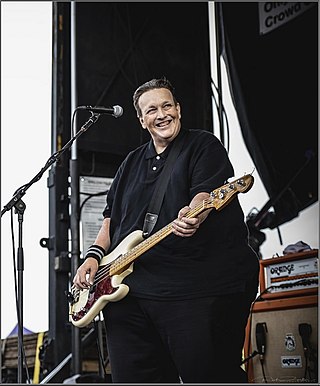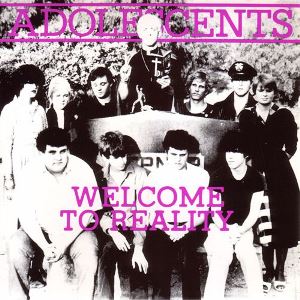The Adolescents are an American punk rock band formed in Fullerton, California in 1979. Part of the hardcore punk movement in southern California in the early 1980s, they were one of the main punk acts to emerge from Orange County, along with their peers in Agent Orange and Social Distortion. Founding bassist Steve Soto was the sole constant member of the band since its inception until his 2018 death, with singer Tony Reflex being in the group for all but one album.

45 Grave is an American rock band from Los Angeles formed in 1979. The original group broke up in 1985, but vocalist Dinah Cancer subsequently revived the band.

Brats in Battalions is the second studio album by the American punk rock band the Adolescents, released in August 1987 on SOS Records, the band's independent record label. It followed a reunion of the band after a five-year breakup, and subsequent lineup changes which saw drummer Casey Royer and original guitarist Frank Agnew replaced, respectively, by Sandy Hanson of the Mechanics and by Agnew's younger brother, Alfie Agnew. Brats in Battalions explores several styles of punk rock and features new recordings of all three songs from 1981's Welcome to Reality EP, as well as cover versions of the traditional folk song "The House of the Rising Sun" and the Stooges' "I Got a Right". Singer Tony Brandenburg left the band after this album, and the Adolescents recorded one more album without him, 1988's Balboa Fun*Zone, before breaking up for another 12 years.

Return to the Black Hole is a live album by the American punk rock band the Adolescents, released in September 1997 on Amsterdamned Records. It was recorded in December 1989 during a reunion performance by the band's 1980–81 lineup.

Richard Francis "Rikk" Agnew Jr. is an American musician with a career spanning more than 40 years. A multi-instrumentalist, he has previously been a member of some of the most influential bands of the Orange County hardcore punk genre, as well as the influential deathrock band Christian Death. During his years with the Adolescents, Agnew became known as one of the best guitarists in the Southern California hardcore punk scene.

Anthony Brandenburg is an American musician best known as the lead singer for the punk rock band the Adolescents. He has used the pseudonyms Tony Cadena, Tony Montana, and Tony Adolescent, and since 1992 has most consistently credited himself as Tony Reflex. Active in music since 1980, he has fronted several bands in addition to the Adolescents—including the Abandoned, the Flower Leperds, ADZ, and Sister Goddamn—and has performed on over 20 studio albums.

Casey A. Royer, is an American musician and an early pioneer of the hardcore punk rock genre in Orange County. He named and formed the band Social Distortion as a teenager. In a career spanning more than 40 years, Royer is best known as the lead vocalist for Southern Californian punk rock band D.I. and as a drummer for the Adolescents.
Francis Thomas "Frank" Agnew is an American guitarist and songwriter, best known for being a member of punk rock band the Adolescents. Frank's brothers Rikk Agnew and Alfie Agnew, as well as his son Frank Agnew Jr., are also former Adolescents guitarists.

Steve Soto was an American musician. Soto was the founding bassist of California punk rock bands Agent Orange and the Adolescents. Soto was also a member of Legal Weapon, Joyride, Manic Hispanic, Punk Rock Karaoke, and the punk supergroup 22 Jacks. Soto also fronted his own band, Steve Soto and the Twisted Hearts, starting in 2008.

D.I. is the eponymously titled debut EP by the American hardcore punk band D.I., released in 1983 through Revenge Records. It was recorded by the band's early lineup of Casey Royer, Rikk Agnew, Tim Maag, Derek O'Brien, Steve Roberts, and Frederic Taccone. The EP was re-released in 1987 by Triple X Records as Team Goon with four additional tracks: The first three—"Nuclear Funeral", "The Saint", and a cover version of Gary Glitter's "Rock and Roll Part II"—were recorded by the band's mid-1980s lineup of Royer, John Bosco, Steve Garcia, and brothers Rikk and Alfie Agnew, while the fourth—a cover version of Devo's "Uncontrollable Urge"—was recorded by the late-1980s lineup of Royer, Bosco, Steve Drt, Sean Elliott, and Hedge.

The Fastest Kid Alive is the fifth studio album by the American punk rock band the Adolescents, released in June 2011 on Concrete Jungle Records. It was the band's first album not to include at least one of the Agnew brothers, and began a string of albums with singer Tony Reflex and bassist Steve Soto as the only constant members. The Fastest Kid Alive was the band's only album with guitarist Joe Harrison, and the first of two with guitarist Mike McKnight and drummer Armando Del Rio.

Balboa Fun*Zone is the third studio album by the American punk rock band the Adolescents, released in 1988 on Triple X Records. Titled after the Balboa Fun Zone amusement area of Balboa Peninsula, Newport Beach, it is the band's only album recorded without singer Tony Brandenburg, who had left the group the prior year. Electing not to replace him, guitarist Rikk Agnew and bassist Steve Soto alternated lead vocals on Balboa Fun*Zone. The album also features the return of original Adolescents guitarist Frank Agnew, who had been absent from their prior album, 1987's Brats in Battalions. Balboa Fun*Zone is also the final Adolescents studio album to include Rikk Agnew and drummer Sandy Hanson. The band broke up in April 1989, reuniting in later years with different lineups.

OC Confidential is the fourth studio album by the American punk rock band the Adolescents, released in July 2005 on Finger Records. It was their first studio album since 1988, and followed their reunion in 2001 after a twelve-year breakup. The album features founding band members Tony Reflex, Frank Agnew, and Steve Soto, joined by drummer Derek O'Brien. It was the final Adolescents album to include Agnew, and their only studio album with O'Brien.

Alfonso F. "Alfie" Agnew is an American mathematician, singer, musician and songwriter. In a career spanning more than 30 years, Agnew is best known for being a member of the punk bands the Adolescents and D.I. as well as the group Professor and the Madman. Alfie's brothers Rikk Agnew and Frank Agnew are also former Adolescents guitarists.
The discography of the Adolescents, a Southern California-based punk rock band, consists of eleven studio albums, three live albums, one compilation album, six EPs, two singles, and one video album.

Welcome to Reality is an EP by the American punk rock band the Adolescents, released in October 1981 on Frontier Records. Recorded after guitarist Rikk Agnew left the group, it was their only release recorded with guitarist Steve Roberts. The band broke up in August 1981, and when the EP was released two months later it was not well received. When the Adolescents re-formed five years later, a new lineup re-recorded all three songs from Welcome to Reality for their reunion album, 1987's Brats in Battalions.

Live 1981 & 1986 is a live album by the American punk rock band the Adolescents, released in 1989 on Triple X Records. It consists of live performances recorded during the band's original 1980–81 run and during their 1986 reunion.

Live at the House of Blues is a live album and concert film by the American punk rock band the Adolescents, released in February 2004 on Kung Fu Records as part of the label's The Show Must Go Off! series. It marked a reunion of the band after a twelve-year breakup, and features songs from their original 1980–81 run and from their then-upcoming reunion album OC Confidential (2005).

The Complete Demos 1980–1986 is a compilation album of demo recordings by the American punk rock band the Adolescents, released in March 2005 on Frontier Records. It includes the band's first three demo tapes, recorded between March and July 1980; one outtake from the recording sessions for their 1981 EP Welcome to Reality; and two songs recorded during their 1986 reunion as demos for their second album, Brats in Battalions (1987). The first eight tracks are the only material recorded by the Adolescents' original lineup, which included guitarist John O'Donovan and drummer Peter Pan. The remaining tracks include their replacements Rikk Agnew and Casey Royer.
"Amoeba" is a song by American punk rock band the Adolescents. It is the eighth track on their self-titled debut album Adolescents, released in April 1981 on Frontier Records. It is the band's signature song.
















